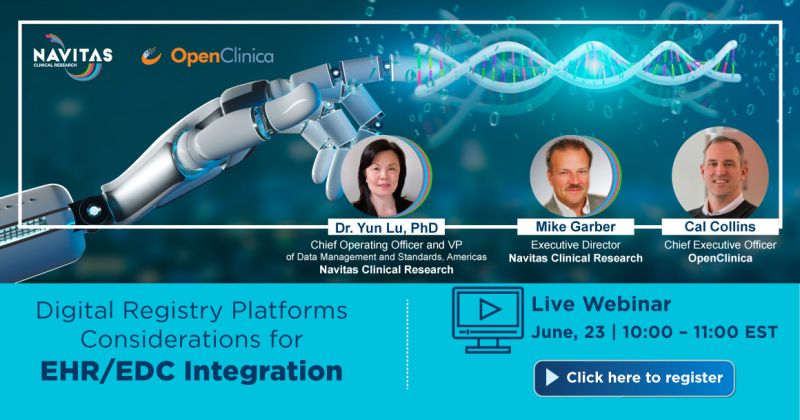Join us as Navitas Clinical Research and OpenClinica proudly present a webinar on “Digital Registry Platforms – Considerations for EHR/EDC Integration.”
The webinar will explore key considerations related to:
- Registry platform planning and consideration
- How EHR data integrated into your EDC can accelerate your registry study
- Optimized digital solutions through the data coordinating center
Not sure if you should attend this webinar? Continue reading to learn more about the webinar in a Q&A between Navitas and OpenClinica, featuring Cal Collins, CEO at OpenClinica.
Hi Cal! Tell us about yourself and your experience in this space.
I’m Cal Collins, the CEO and Co-Founder at OpenClinica. Our vision is to drive the future of digital clinical trials with innovative technology and more seamless integration with the healthcare system. I have co-led a collaboration with an OpenClinica client and the FDA that won Bio-IT World’s 2022 Innovative Practice Awards for their work on the OneSource initiative integrating EHR and EDC systems. Having been active in standards development work for many years, including as a member of CDISC’s Operational Data Model V2 feature team and the HL7 Vulcan Advisory Council, I’m grateful and humbled to see our work recognized and, more importantly, to witness the impact that it has on clinical research.
Cal is a graduate of Harvard University and his work has been featured in publications such as Clinical Research News, Medhealth Outlook, Bioinformatics, ACM/IEEE, and Clinical Leader. He has keynoted, presented, and/or organized sessions at events including the DIA Annual Meeting, SCDM Annual Conference, Society for Clinical Trials, American Medical Informatics Association’s Annual Symposium, the Open Source Electronic Health Records Alliance (OSEHRA) and the tranSMART Annual Meeting.
Cal also sits on the board of Isovera, LLC, a digital agency. When not working, he enjoys sailing, gardening, exercising, and spending time with his twin boys.
Why is Electronic Health Record (EHR) and Electronic Data Capture (EDC) integration important for a registry study?
EDC systems are typically used in registry studies for reporting and data capture purposes. However, a lot of that data already exists in the EHR, so by integrating and automating EHR data into the EDC, we remove burden from patients, data managers, principal investigators, and other clinical trial stakeholders. As more data is collected by physicians and clinicians, it can be entered into their electronic health record (EHR) which is then be easily populated into the EDC to contribute real-world data for clinical research around specific diseases and disorders. For registry studies specifically, having bulk data at our fingertips makes a world of a difference, especially because it removes the burden of manually transcribing all of that data.
How does EHR-EDC integration help improve efficiency?
Interoperability between the EHR and EDC improves efficiency in so many ways. OpenClinica Unite is an EHR eSource solution that enables clinical researchers to pull data from the EHR into the EDC with one click. In one example, the data shows that this process once took a clinical research coordinator 60 minutes to transcribe from one system to another using traditional methods which require manual transcription. We were able to reduce the time spent on data migration down to 5 minutes, saving the clinical research team hundreds of hours over the lifespan of a clinical trial.
How does EHR integration work?
The Basics: In our case, OpenClinica Unite can be easily launched by clinicians, investigators, and clinical research coordinators from within the patient’s chart in the EHR. This functionality removes the need to separately log into research applications. OpenClinica Unite also provides summaries, trends, and visualizations of key information in ways that enhance safety and data quality while also supporting clinical care. Available in both a desktop and mobile version, OpenClinica Unite allows users to safely, accurately, and efficiently view study data where and when it is most needed.
Site Implementation, Integration, and Standardization: OpenClinica Unite is a secure, standards-based technology that is widely accepted by health system IT departments and backed by major EHR vendors. With no software to install, implementation is lightweight and fast. Once implemented at the site, OpenClinica Unite is immediately reusable across multiple trials and sponsors thanks to its scalable design. Lastly, not all sites need to use OpenClinica Unite. It fully supports hybrid models where select sites can be enabled.
Regulatory Compliance with Automated EHR eSource Data Capture: OpenClinica Unite greatly reduces the burden of capturing regulatory-grade, structured data for participating clinical trial sites. Built with rigorous compliance in mind, OpenClinica Unite is 21 CFR Part 11 and ICH GCP compliant. Traceability to the source is also built into the solution, capturing data originator and data element identifiers per FDA 2018 EHR guidance.
You can join Cal Collins from OpenClinica and Yun Lu from Navitas for an engaging webinar about digital registry platforms and the considerations for EHR/EDC integration.
Webinar Details
Title: Digital registry platforms – Considerations for EHR/EDC Integration
When: Thursday, June 23, 2022 at 10:00 AM ET
Who: Co-hosted by Navitas and OpenClinica

